Books &Disney 28 Oct 2010 07:47 am
Reviews-a-Plenty
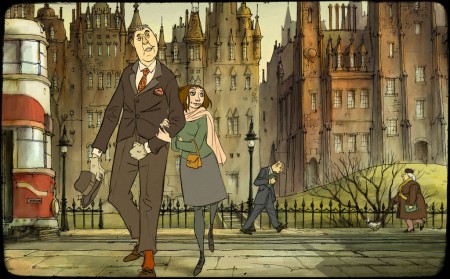
- Mark Mayerson has given an initial review of The Illusionist. I’ve waited a while to see this feature. I’d intended to go to Ottawa, not only to represent my film shown there, but to see this new film from Sylvain Chomet. The first screening I will be able to attend is on Wednesday Nov. 10th.
Richard O’Connor in his short review at his site Asteriskpix.blogspot, left me something to think about, but he didn’t feel it was the best of the features at the Festival. Mark Mayerson certainly did. In the comments section of Mark’s site, Richard extends his review telling me, clearly, that I’ll have to judge for myself.
Mark’s review is answers some of the questions I wondered about. He predominantly focuses in on the story elements and leaves plenty for us to digest. His comparison to not only other animated features but live action, as well, takes this review to a high level, which is where Mark seems to be placing this film and where he always writes from.
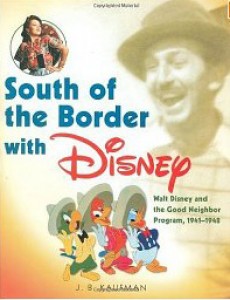 - Michael Barrier has reviewed the two important, relatively-new books: South of the Border with Disney by J.B. Kaufman and Two Guys Named Joe by John Canemaker.
- Michael Barrier has reviewed the two important, relatively-new books: South of the Border with Disney by J.B. Kaufman and Two Guys Named Joe by John Canemaker.
The review is quite long and goes into plenty more about Disney and his employees, covering all the times that Joe Grant would have been working there. Barrier talks more about Grant than about the book’s other half, Joe Ranft. This gives a wider view of the studio. Since Barrier has less interest (admittedly this goes for me as well) in Ranft, he’s give short shrift in this review.
There’s quite a bit about the anti-Semitic remarks Disney and others made and faced at the studio. There’s plenty about the importance (or non-importance) of those travelling with Walt for any length of time. And, most importantly, there’s an analysis of others with equal position to Grant in making the films at the studio – particularly as to how the person was moved by Disney into other branches of work as the studio transitioned into live action and television.
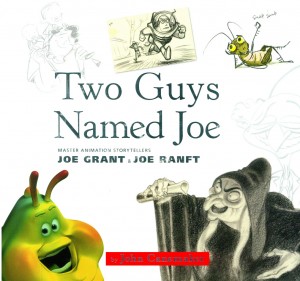 Finally, Mike’s take is that all-things-Disney is starting to get tiresome. He questions whether the two books would have been written differently if they weren’t published by Disney. This was a question I’d asked as well, though I didn’t have the courage to add it to my reviews.
Finally, Mike’s take is that all-things-Disney is starting to get tiresome. He questions whether the two books would have been written differently if they weren’t published by Disney. This was a question I’d asked as well, though I didn’t have the courage to add it to my reviews.
It’s another excellent commentary article by Mike and is a must read for anyone interested in animation. As with some of his other recent reviews, I more taken with some of the side notes – slight tangents Barrier takes – than with that which is directly addressing off the book. The article doesn’t flinch in calling the shots against the authors, although I know that Mike is very sensitive, expecially in this piece, in not wanting to hurt either of the two authors.
 - This pushes me into doing my job of reporting on two books I’ve meant to cover for some time. Ken Priebe‘s excellent The Advanced Art of Stop-Motion Animation is a follow-up to his first book, The Art of Stop-Motion Animation.
- This pushes me into doing my job of reporting on two books I’ve meant to cover for some time. Ken Priebe‘s excellent The Advanced Art of Stop-Motion Animation is a follow-up to his first book, The Art of Stop-Motion Animation.
The first book was a primer about the art of that medium. Ken covered it thoroughly and gracefully. He not only revealed many of the secrest of the process, but he gave plenty of examples of other stop=motion animation which elucidated on the art.
The second book is much more involved with many of the films out there. There’s a good history of the medium in this book, and I was not disappointed to find some of the rare pieces from the early days. Just look into the films of Starewicz (Americanized as “Starewich”, here), and you’ll read plenty that you might not know. The same goes for A. Ptushko and G. Pal. There’s also plenty said about newer stop-motion. Caroline, The Fantastic Mr. Fox and The Corpse Bride are well covered.
The illustrations are plentiful and large, and the book comes with a DVD so that you can view some of the exercises in the book.
Ken Priebe loves the medium of stop-motion. He often advises me of some rare piece he’s found and put up on YouTube. These are often gems in good quality. He brings that same love of this often-neglected branch of animation to the book at hand. If you, too, have any love of the form, get this book.
It’s a paperback published by Course Technology PTR
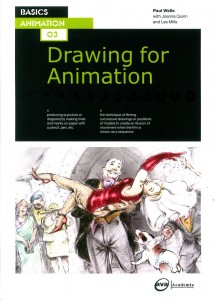 The second book I’d like to present to you is Drawing for Animation by Paul Wells with substantial help from Joanna Quinn and Les Mills.
The second book I’d like to present to you is Drawing for Animation by Paul Wells with substantial help from Joanna Quinn and Les Mills.
Need I say more than Joanna Quinn to get you interested in this book? Her films are brilliantly drawn works of art, as if Daumier had come to life. The drawing in this book is outstanding as well, and we’re treated to a plentiful look at her art – from storyboards to animation drawings to final setups. My only complaint is that the images are small. One wishes it were on line so you could click the thumbnails and enlarge. Alas, it’s a book, and we have to settle for the thumbnails (or scan and enlarge them ourselves as I did at the end of this review.)
The use of drawing is detailed and instructed through many many examples and it’s all worth studying. Paul Wells’ writing is clear and concise, and he well uses examples to illustrate his thoughts. This book is a little gem and I recommend it highly for any animation (especially 2D animation) lover.
The book is a paperback published by Ava|Academia.
Here are a couple of the other illustrations in the book which you can enlarge by clicking:
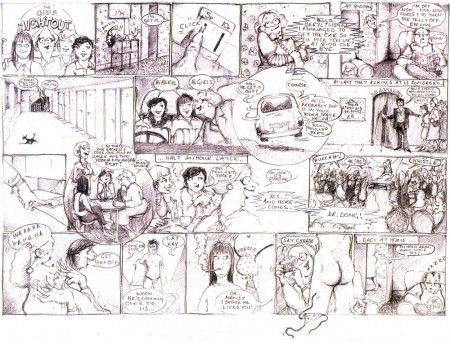
A comic book version of a storyboard
for the film A Girl’s Night Out.
An unorthodox method that energized the film.
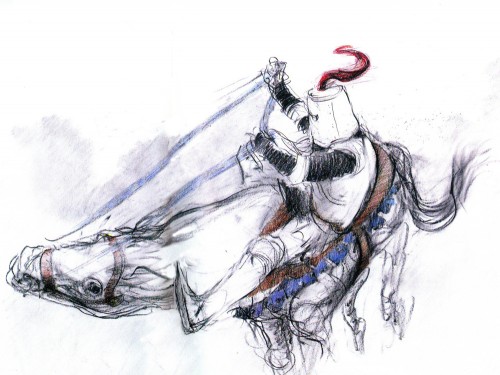
A study for The Knight Riding Horse 0f Wife Of Bath
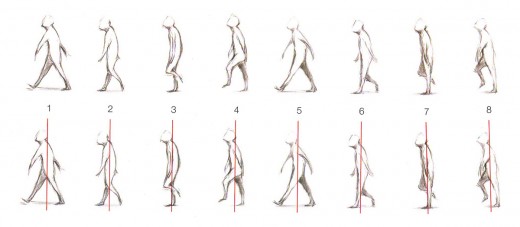
A walk cycle which I put through a QT movie (on threes) below.

on 28 Oct 2010 at 8:24 am 1.Steven Hartley said …
Also, today is October 28 and it’s actually animator Don Lusk’s birthday – yes, Don is still alive, as Joe Campana told me and to find out more, please see this:
http://blabbingonartsandculture.blogspot.com/2010/10/happy-birthday-don-lusk.html
on 28 Oct 2010 at 9:03 am 2.Oscar Grillo said …
“The Illusionist” was a film that brought tears to my eyes for its now impossible to find Zen like simplicity. Everyone should discover whatever he or she wants watching it, but I will advise to do it thinking about what the title says. That is a film about ILLUSION (Illusion as in “La Grand Ilussion” of course). A masterpiece.
on 28 Oct 2010 at 10:32 am 3.The Gee said …
is World Animation Day today or was it yesterday?
Oh…..by the way……
Thanks for the links to the reviews and to the reviewing of the reviews.
on 28 Oct 2010 at 11:00 am 4.Richard O'Connor said …
I think many who feel the Disney model of feature films is the superior model (if only they’d produce something beyond toddler pictures) will gravitate towards “The Illusionist.”
Oscar, as always, makes a good point. The title gives the picture an added weight. That’s courtesy of the script more than the direction.
In another year it may well have been the best in show. This year the two others I saw were far more touching and vastly more enthralling -despite their poor animation. They were in every way the opposite of “The Illusionist”. It’s my understanding that a fourth film from Japan was also extraordinary.
“The Illusionist” is a step up from “Belleville”, as in that picture there’s a lot to like and a lot that can leave you cold.
on 28 Oct 2010 at 12:20 pm 5.Eric Noble said …
I’ve read Michael Barrier’s review of the books, and he does bring up an interesting point, especially about Walt Disney. He was such a fascinating man, and yet his company is doing all they can to squash that into the Approved Narrative, while his detractors try to do something similar with his darker traits. These books definitely have attracted my attention, and I wish I can get them.
That does lead me to ask a question though. He talks about the artistic merits of the films the books talk about. What standards would one use to discuss the artistic merits of Disney or Pixar?
I’m looking forward to Joanna Quinn’s book. Her drawings are AMAZING!!!
on 28 Oct 2010 at 12:32 pm 6.Michael said …
Eric, personally I’m still looking for the artistic merits, but I don’t find much to buoy myself. I did find a lot to say for the individual expression that infrequently rose to the top in Ratatouille, but not much else in recent films (meaning since The Black Cauldron up. It’s too much a team effort for individuals to shine. And though films like Mulan or Lilo and Stitch have extraordinary moments in them (especially in the art direction of the BGs) I don’t think of these things as work of Art, but more as work of Craft. Something like My Dog Tulip or Triplettes of Belleville have more to speak to Art, for my taste.
on 28 Oct 2010 at 12:54 pm 7.Eric Noble said …
Okay, so you’re saying you look for an individual expression in such films, an overall sense of a guiding hand in these films. Do you find that in Disney films made when Walt was alive? Those were team efforts as well. Do you find that in films such as Pinocchio or Dumbo? I’m just trying to find out what you mean.
on 28 Oct 2010 at 1:58 pm 8.Michael said …
Yes, there was more of a guiding hand in some of the early features. SNOW WHITE was the greatest for that, PINOCCHIO, BAMBI and DUMBO certainly as well. Disney was seeking what he wanted, and there was no doubt he was making the decisions. FANTASIA has moments, but not as many.
This seems to have gone by the time they did CINDERELLA.
on 29 Oct 2010 at 8:59 am 9.Dave Levy said …
Stimulating stuff here, as is often on this blog.
One thing that is problematic for me is the idea that those early Disney features are made artists while newer works (like today’s Pixar films are not). Michael Barrier makes that point in his book review. I see the temptation to take that point of view especially since:
A) The golden age films are established classics that everyone holds in high regard
B) Time has allowed us to know the individual contributions of those artists and analyze what each of them brought to their scenes, what their specialties were, etc. I don’t anyone watching Dumbo in 1941 would have said, “Oh, that looked like a Babbitt scene, but now I think this is Fred Moore.”
With this in mind, we can’t possibly know what individuals are contributing today. We are too close to it. These careers and artistic lives are still in spin, not under a museum glass to study in context yet. Its much too easy to dismiss it.
on 29 Oct 2010 at 9:01 am 10.Dave Levy said …
Sorry for all the typos in my comment. I shouldn’t be eating breakfast as I type. haha.
on 05 Dec 2012 at 8:46 am 11.for self-study animation « A_mysterious_universe said …
[...] for self-study animation [...]